
Global Ecology and Conservation
Scope & Guideline
Pioneering research in the heart of conservation efforts.
Introduction
Aims and Scopes
- Biodiversity Conservation:
The journal emphasizes research aimed at understanding and conserving biodiversity at various scales, including species, populations, and ecosystems. This includes studies on endangered species, habitat loss, and the effectiveness of conservation strategies. - Ecosystem Services:
Research on the relationship between ecosystems and human well-being is a core focus. This includes assessing how ecosystem services can be managed and conserved to benefit both nature and society. - Climate Change Impacts:
The journal publishes studies that explore the effects of climate change on various ecological processes and species distributions, as well as strategies for mitigation and adaptation in conservation practices. - Human-Wildlife Interactions:
Understanding the dynamics of human-wildlife interactions is crucial for effective conservation. The journal includes research on conflict mitigation, community perceptions, and the role of local communities in conservation efforts. - Ecological Modeling and Monitoring:
The use of ecological modeling, remote sensing, and innovative data collection methods (such as eDNA and citizen science) to monitor biodiversity and assess conservation outcomes is a significant area of interest. - Restoration Ecology:
The journal encourages research on ecological restoration practices, including the restoration of degraded habitats and the reintroduction of species, to enhance biodiversity and ecosystem resilience.
Trending and Emerging
- Interdisciplinary Approaches to Conservation:
There is an increasing trend towards integrating social sciences with ecological research to address conservation challenges. This includes understanding community values, economic factors, and cultural contexts that influence conservation outcomes. - Technological Innovations in Monitoring:
The use of advanced technologies, such as remote sensing, environmental DNA (eDNA), and machine learning, for biodiversity monitoring and conservation planning is on the rise. These tools are enhancing the ability to collect and analyze ecological data more efficiently. - Restoration Ecology and Climate Resilience:
Research focusing on ecological restoration as a means to enhance climate resilience is gaining traction. This includes studies on restoring ecosystems to mitigate the impacts of climate change and improve biodiversity. - Community Engagement and Citizen Science:
There is a growing emphasis on involving local communities and citizen scientists in conservation efforts. Studies that highlight participatory approaches and local knowledge have become more prevalent, reflecting a shift towards inclusive conservation practices. - Ecosystem-Based Management:
The journal is increasingly publishing research that advocates for ecosystem-based management strategies, which consider the interconnectedness of species and habitats, rather than isolated management practices.
Declining or Waning
- Traditional Species-Focused Conservation:
There is a noticeable shift away from purely species-centric conservation studies towards more holistic approaches that incorporate ecosystem dynamics and human interactions. This trend suggests a waning emphasis on isolated species studies. - Invasive Species Research:
Although still relevant, the frequency of papers solely focused on invasive species management appears to be declining. The current trend favors integrated management strategies that consider ecological context rather than focusing on invasive species alone. - Laboratory-Based Studies:
Research conducted in controlled laboratory settings is becoming less prevalent compared to field studies. The emphasis is shifting towards understanding ecological processes in real-world contexts, which may lead to less focus on laboratory research. - Local Case Studies:
There seems to be a reduction in the number of localized case studies that do not contribute to broader ecological theories or frameworks. The journal is increasingly favoring studies that have implications for global conservation strategies.
Similar Journals
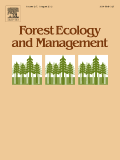
FOREST ECOLOGY AND MANAGEMENT
Elevating Knowledge in Forest EcosystemsFOREST ECOLOGY AND MANAGEMENT is a premier peer-reviewed journal dedicated to the integral study of forest ecosystems and their management, published by Elsevier in the Netherlands. With an impactful presence in the field, this journal boasts a prestigious Q1 ranking in multiple categories, including Forestry, Management, Monitoring, Policy and Law, and Nature and Landscape Conservation as of 2023. It addresses key issues relevant to sustainable forest practices, conservation strategies, and environmental monitoring, making it a vital resource for researchers, practitioners, and policymakers alike. The journal is indexed with an impressive Scopus rank, placing it among the top tier of titles in Agricultural and Biological Sciences and Environmental Science. While it does not offer Open Access options, its rigorous review process and high visibility make it essential for those seeking to stay abreast of the latest findings and trends in forest ecology and management. Published continuously since 1976, FOREST ECOLOGY AND MANAGEMENT aims to foster interdisciplinary collaboration and advance knowledge critical to the stewardship of forest resources in an ever-changing global landscape.

Folia Oecologica
Empowering Open Access to Vital Ecological Research.Folia Oecologica is a distinguished open-access journal published by WALTER DE GRUYTER GMBH, focusing on critical research in the fields of agricultural and biological sciences, ecology, and forestry. Established as a vital platform for the dissemination of knowledge, this journal has been providing free access to its valuable content since 2017, catering to an international audience engaged in environmental and ecological studies. With its ISSN 1336-5266 and E-ISSN 1338-7014, Folia Oecologica has earned notable ranks in Scopus, placing it in the 62nd percentile for Agricultural and Biological Sciences and the 50th percentile for Environmental Science. The journal's commitment to high-quality research is reflected in its positions in the Q2 and Q3 quartiles across various categories in 2023. As it converges years from 2006 to 2024, Folia Oecologica continues to foster scholarly dialogue and collaboration among researchers, professionals, and students, making significant contributions to the understanding and preservation of our ecological systems.

Journal of Wildlife and Biodiversity
Exploring the depths of biodiversity.Journal of Wildlife and Biodiversity, published by Arak University in Iran, is an Open Access journal that has been contributing to the fields of wildlife science and biodiversity since its inception in 2017. With an E-ISSN of 2588-3526, this journal serves as a vital platform for researchers, professionals, and students alike, dedicated to disseminating significant findings related to animal sciences, ecology, and environmental conservation. Despite its current Q4 ranking in various categories (Animal Science, Ecology, and Nature and Landscape Conservation) according to the 2023 metrics, the journal's commitment to advancing knowledge in wildlife and biodiversity remains unwavering. Although the journal's Scopus coverage has been discontinued since 2024, it continues to cater to a wide audience by promoting innovative research and fostering collaborations in the academic community, ultimately aiming to enhance understanding and conservation strategies for wildlife and their habitats.

Journal of Fish and Wildlife Management
Exploring the intersection of ecology and wildlife management.The Journal of Fish and Wildlife Management, published by the U.S. Fish & Wildlife Service, serves as a vital resource for scholars, researchers, and professionals in the fields of Animal Science, Ecology, and Conservation Biology. With its ISSN 1944-687X, this esteemed journal has been disseminating critical research findings since 2010, contributing significantly to the understanding of fish and wildlife conservation practices and their ecological impacts. Despite its Q3 category rankings in various disciplines as of 2023, it provides a platform for innovative research that influences policy and management strategies for biodiversity conservation. The journal, although not open access, remains committed to advancing the scientific discourse surrounding wildlife management with articles that emphasize practical conservation efforts and ecological sustainability. Readers can expect a diverse range of articles that promote best practices in the management and conservation of fish and wildlife resources, furthering our collective mission of preserving ecological health and biodiversity for future generations.
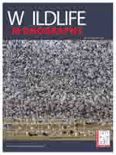
WILDLIFE MONOGRAPHS
Elevating the discourse on ecological and biological sciences.WILDLIFE MONOGRAPHS, published by WILEY, is a prestigious journal dedicated to advancing the understanding of ecological and biological sciences with a keen focus on wildlife conservation and management. With an ISSN of 0084-0173 and an E-ISSN of 1938-5455, this journal has established itself as a leader in its field, ranking in the Q1 quartile for both Ecology, Evolution, Behavior and Systematics and Nature and Landscape Conservation in 2023. The journal's remarkable impact is underscored by its Scopus rankings—46th out of 721 in Agricultural and Biological Sciences and 17th out of 211 in Environmental Science, highlighting the journal's influential role in shaping research discussions and policy in wildlife management. Available in print and online, WILDLIFE MONOGRAPHS publishes comprehensive studies that inform practitioners, researchers, and students alike, fostering a deeper insight into biodiversity and ecosystem dynamics. Founded in 1981, the journal continues to evolve, contributing significantly to the scientific community through rigorous peer-reviewed articles that bridge the gap between theory and practical application in wildlife management.
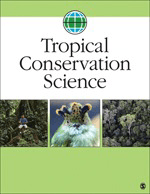
Tropical Conservation Science
Empowering research to protect tropical biodiversity.Tropical Conservation Science, an esteemed journal published by SAGE Publications Inc, plays a pivotal role in the field of environmental science, particularly within the realms of ecology and nature conservation. Established as an Open Access platform since 2008, it facilitates global dissemination of critical research findings dedicated to the preservation of tropical ecosystems. With an impressive impact factor reflected in its Q2 rankings within both ecology and nature landscape conservation categories for 2023, the journal is ranked in the 66th percentile for Environmental Science and maintains a strong position in the academic community. The journal’s scope encompasses a wide array of tropical conservation issues and aims to foster interdisciplinary collaboration among researchers, professionals, and students committed to advancing conservation strategies. Tropical Conservation Science is not merely a publication; it's a vital resource contributing to the safeguarding of our planet's biodiversity.
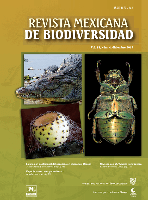
Revista Mexicana de Biodiversidad
Advancing the Science of Biodiversity in Mexico and BeyondRevista Mexicana de Biodiversidad is a prominent academic journal dedicated to the field of biodiversity and conservation, published by the prestigious Instituto de Biología, Universidad Nacional Autónoma de México. Since its inception as an Open Access publication in 2005, it has aimed to disseminate high-quality research that advances the understanding of biological diversity in Mexico and beyond. With an ISSN of 1870-3453 and an E-ISSN of 2007-8706, the journal caters to a diverse audience, including researchers, professionals, and students, by providing vital insights into ecological studies, conservation strategies, and the sustainable management of natural resources. The journal is committed to fostering scientific collaboration and promoting the significance of biodiversity in addressing contemporary environmental challenges. By publishing innovative and impactful research, the Revista Mexicana de Biodiversidad plays an essential role in the global discourse on biodiversity conservation.
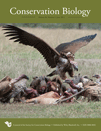
CONSERVATION BIOLOGY
Empowering conservation through rigorous scientific discourse.CONSERVATION BIOLOGY, published by Wiley, is a leading journal in the field of ecology and conservation, with a focus on disseminating high-quality research that addresses pressing environmental challenges. With a strong impact factor and categorized in the top quartile (Q1) across various relevant fields including Ecology, Evolution, Behavior and Systematics, and Nature and Landscape Conservation, the journal plays a pivotal role in advancing the scientific understanding of biodiversity and conservation practices. Since its establishment in 1987, CONSERVATION BIOLOGY has provided a vital platform for researchers, professionals, and students to share innovative findings and facilitate discussions surrounding ecological sustainability and conservation strategies. Although it is not an open-access publication, it ensures that a wide range of significant research is accessible to the global scientific community. The journal’s rigorous peer-review process and reputation for excellence make it an essential resource for anyone involved in the study of ecology and conservation.
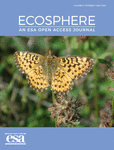
Ecosphere
Fostering collaboration in the pursuit of ecological knowledge.Ecosphere is a leading open-access journal published by WILEY, dedicated to advancing research in the fields of ecology, evolution, behavior, and systematics. Established in 2010 and headquartered in the United States, this innovative journal provides a platform for the exchange of cutting-edge scientific knowledge and discovery, fulfilling its mission to enhance our understanding of ecological systems and their interactions. With a prestigious impact factor reflecting its commitment to high-quality research, Ecosphere is ranked Q1 in both Ecology and Ecology, Evolution, Behavior, and Systematics for 2023, further solidifying its prominence in the scientific community. The journal's scope includes a wide array of topics related to environmental science, making it an essential resource for researchers, professionals, and students aiming to stay at the forefront of ecological research. It offers comprehensive open access options, ensuring that groundbreaking findings are readily available to a global audience, thus fostering collaboration and innovation in the field.
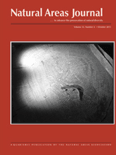
NATURAL AREAS JOURNAL
Championing the Future of Natural Area ConservationNATURAL AREAS JOURNAL, published by the NATURAL AREAS ASSOCIATION, serves as a vital resource for scholars and practitioners in the fields of ecology and nature conservation. Since its inception in 1993, this quarterly academic journal delivers original research, case studies, and reviews that focus on the preservation of natural areas and the intricate relationships within ecosystems. The journal, indexed under ISSN 0885-8608 and E-ISSN 2162-4399, currently holds a Q3 quartile ranking in both Ecology and Nature and Landscape Conservation as of 2023, reflecting its commitment to advancing knowledge in these essential areas. With Scopus rankings placing it at the 39th percentile in Nature and Landscape Conservation and 36th in Ecology, the NATURAL AREAS JOURNAL is an influential platform that fosters interdisciplinary collaboration and advocacy for conservation efforts. Although it currently does not offer Open Access options, its contributions are pivotal for researchers, professionals, and students seeking to explore, understand, and contribute to conservation science.